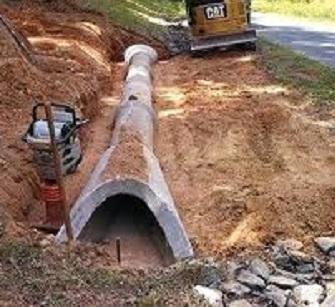Safe and Reliable Tree Removal Solutions
Safe and Reliable Tree Removal Solutions
Blog Article
Culvert Installation Facilitated: Step-by-Step Overview for Success
Installing culverts might feel like a simple job, yet guaranteeing a successful end result requires cautious planning and implementation. From selecting the ideal culvert size to incorporating correct water drainage steps, each step in the installment process plays an important duty in the performance and long life of the culvert system. By following a systematic technique and paying attention to key details, the installment can proceed efficiently, lessening potential concerns down the line. Keep tuned to discover the essential actions and factors to consider that can make culvert setup a smooth and effective venture.
Picking the Right Culvert Dimension
Choosing the appropriate culvert dimension is important for making sure reliable water flow and structural stability in culvert installment jobs - Pad Construction. The size of the culvert straight affects the circulation capacity of water through the structure. A culvert that is also little can bring about flooding and overflow, while one that is as well huge may lead to reduced water rate, potentially triggering debris buildup and clogs
To figure out the right culvert size, elements such as the watershed area, height flow rates, and hydraulic performance demand to be meticulously thought about. Estimations based upon these specifications assist in choosing a dimension that can properly take care of the anticipated water volume while minimizing the danger of obstructions and architectural failing.
It is important to consult engineering guidelines and standards to make certain that the chosen culvert dimension fulfills the job demands and neighborhood laws (Pad Construction). By choosing the ideal culvert dimension, job supervisors can enhance water flow, protect against potential issues, and enhance the general effectiveness and long life of the culvert setup
Preparing the Installment Website
Effective culvert installment demands thorough prep work of the setup website to make sure ideal structural support and performance. Prior to beginning the setup procedure, it is vital to remove the website of any type of particles, plant life, or obstructions that could hamper the culvert's positioning. Guaranteeing a degree foundation is important for the proper placement and stability of the culvert. This may entail grading the website to produce a smooth, even surface area that can appropriately sustain the weight of the culvert and any type of anticipated lots. Additionally, appropriate compaction of the soil below the culvert is needed to avoid resolving or changing with time.
Moreover, it is important to consider aspects such as soil make-up, groundwater degrees, and ecological impacts when preparing the installment site. Performing an extensive site evaluation can aid determine any potential challenges or threats that may influence the culvert's efficiency. By making the effort to prepare the installment site correctly, you can assist guarantee a successful culvert setup that meets structural requirements and makes sure long-lasting performance.
Positioning the Culvert Properly

The grade at which the culvert is put is essential for preserving a proper slope for water flow. Additionally, the culvert should be oriented correctly to guarantee that the inlet and outlet are in the appropriate locations. Pad Construction.
Backfilling and Compacting the Dirt
Appropriate backfilling and compaction of the dirt around the culvert is important to ensure security and avoid potential issues in the future. As soon as the culvert is properly put, the following crucial action is to backfill the area around it with ideal material. The backfill material ought to additional reading be complimentary from rocks, debris, and organic issue to avoid damage to the culvert. It is suggested to use granular material such as sand or crushed rock for backfilling, as it offers excellent drainage and compaction residential properties.
Compaction aids in lowering the possibilities of negotiation and ensures uniform support around the culvert. It is important to portable the soil uniformly on all sides of the culvert to keep its structural honesty.
Proper backfilling and compaction not only offer stability to the culvert however also assist in preventing soil erosion and maintaining the long life of the culvert system.
Making Certain Proper Drainage Integration
Integrating reliable drain remedies plays an important duty in the total capability and longevity of culvert installations. Proper drainage assimilation is essential for taking care of water flow, avoiding erosion, and guaranteeing the architectural stability of the culvert system. To achieve this, it is crucial to create an extensive water drainage plan that takes into consideration elements such as the volume of water expected, the topography of the location, and the kind of dirt existing.

In addition, integrating features like disintegration control actions, such as riprap or greenery, can further improve the effectiveness of the drainage system. By very carefully intending and implementing these drainage remedies, culvert setups can work efficiently and endure the test of time.
Final Thought
In conclusion, appropriate culvert installment is important for keeping effective water drainage systems. By choosing the appropriate culvert size, preparing the installment website, positioning great site the culvert properly, backfilling and condensing the soil, and ensuring correct drainage integration, success can be achieved. Following these actions will help guarantee the longevity and effectiveness of the culvert, ultimately adding to the total success of the drainage system.
Report this page